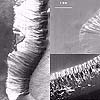 |
NASA scientists have discovered how an intricate martian network of streams, rivers and lakes may have carried water across Mars. Using new three-dimensional data from the Mars Global Surveyor spacecraft and a powerful state-of-the-art computer code that 'models' overland water flow, scientists visualized the complex flow of martian water. These data, acquired by the laser altimeter on board the spacecraft, provided highly accurate, three-dimensional topographic views of Mars. "We've known for some time that Mars contains lakebed and stream-like surface features, and that many of these stream features run into depressions, then end abruptly," said Marc G. Kramer, a visiting National Research Council scientist at NASA Ames Research Center in California's Silicon Valley. Kramer is principal author of a peer-reviewed news article about the study that recently appeared in EOS, a weekly American Geophysical Union publication. "A new aspect of this study shows how these two features link to one another as a single, integrated water network that may have existed on Mars at some time in the past," he said. The study spans portions of the equatorial region on the martian highlands that extend from the northern mid latitudes to the southern mid latitudes. Kramer's co-authors are Christopher Potter, David Des Marais and David Peterson, all from NASA Ames. Scientists have long been puzzled as to why some ancient river-like features on the red planet do not seem to connect to one another and often lack smaller stream features. "If you look at a photograph of the surface of Mars, the river features begin and end abruptly, and often lack small-scale features," Kramer said. "Many scientists have argued that these features were formed from localized groundwater seeping to the surface. Others have argued that these features formed from precipitation during a time when Mars may have had a thicker atmosphere." "What we found in this study, is that many of these apparently fragmented river features may have connected or flowed into depressions that resemble ancient lake beds," Kramer explained. "Some of the larger depressions are comparable in size to the Great Lakes in North America in terms of surface area." In addition, some of the larger depressions of the main channel system are comparable in volume to Lake Erie, the smallest of the Great Lakes in North America, Kramer added. Large lakes and rivers on Mars once may have formed water systems that included many streams and smaller lakes, according to the scientists. The study found that the areas near the Great Lakes on Earth bear a strong resemblance to features on Mars. Although the areas appear to be similar, they formed in different ways, according to Kramer. The study of surface depressions in conjunction with river features, provides a more complete picture of a surface water network that may have existed on what must have been a warmer early Mars, according to Potter. The researchers excluded fresh impact crater areas during the analysis in order to study older drainage patterns. "The larger shallow depressions in the main channel system often contain multiple, highly eroded craters and show evidence of stream features in the extensive upland regions draining into them," Kramer said. These depressions become increasingly shallow downstream, suggesting that increased sedimentation may have been deposited by water or ice that once may have flowed through them, according to the scientists. "Still unclear is how long such a water system may have persisted, and under exactly what climate conditions," he said. "The answers to these questions may lie in further examination of the sediments that have accumulated across the depressions of the surface water network." "New instruments on the Mars Odyssey spacecraft, including the Thermal Emission Imaging System (THEMIS) instrument, address these questions," Kramer said. THEMIS infrared and visible light images have revealed a diversity of surface types and features. Nighttime temperature images show complex patterns of rock layers, rocky debris, sand and dust produced by impact cratering, wind erosion, volcanism and deposition. "The data coming out of the Mars Global Surveyor and Mars Odyssey Mission are quite revealing," Kramer said. "We were able to study the planet in ways that were previously not possible." "With an abundance of ice recently detected just below the surface of Mars, the possibility that life has existed or still may exist may hinge on its past climate and the duration of surface water flows," Potter said. "Was Mars ever a warm and wet planet, or has it always been cold and dry?" he asked. Related Links Mars at JPL SpaceDaily Search SpaceDaily Subscribe To SpaceDaily Express  Melbourne - Jan 06, 2003
Melbourne - Jan 06, 2003An Australian geologist has identified what could be the first ever active flow of fluids through gullies on Mars.
|
| ||||||||||
| The content herein, unless otherwise known to be public domain, are Copyright 1995-2016 - Space Media Network. All websites are published in Australia and are solely subject to Australian law and governed by Fair Use principals for news reporting and research purposes. AFP, UPI and IANS news wire stories are copyright Agence France-Presse, United Press International and Indo-Asia News Service. ESA news reports are copyright European Space Agency. All NASA sourced material is public domain. Additional copyrights may apply in whole or part to other bona fide parties. Advertising does not imply endorsement, agreement or approval of any opinions, statements or information provided by Space Media Network on any Web page published or hosted by Space Media Network. Privacy Statement All images and articles appearing on Space Media Network have been edited or digitally altered in some way. Any requests to remove copyright material will be acted upon in a timely and appropriate manner. Any attempt to extort money from Space Media Network will be ignored and reported to Australian Law Enforcement Agencies as a potential case of financial fraud involving the use of a telephonic carriage device or postal service. |